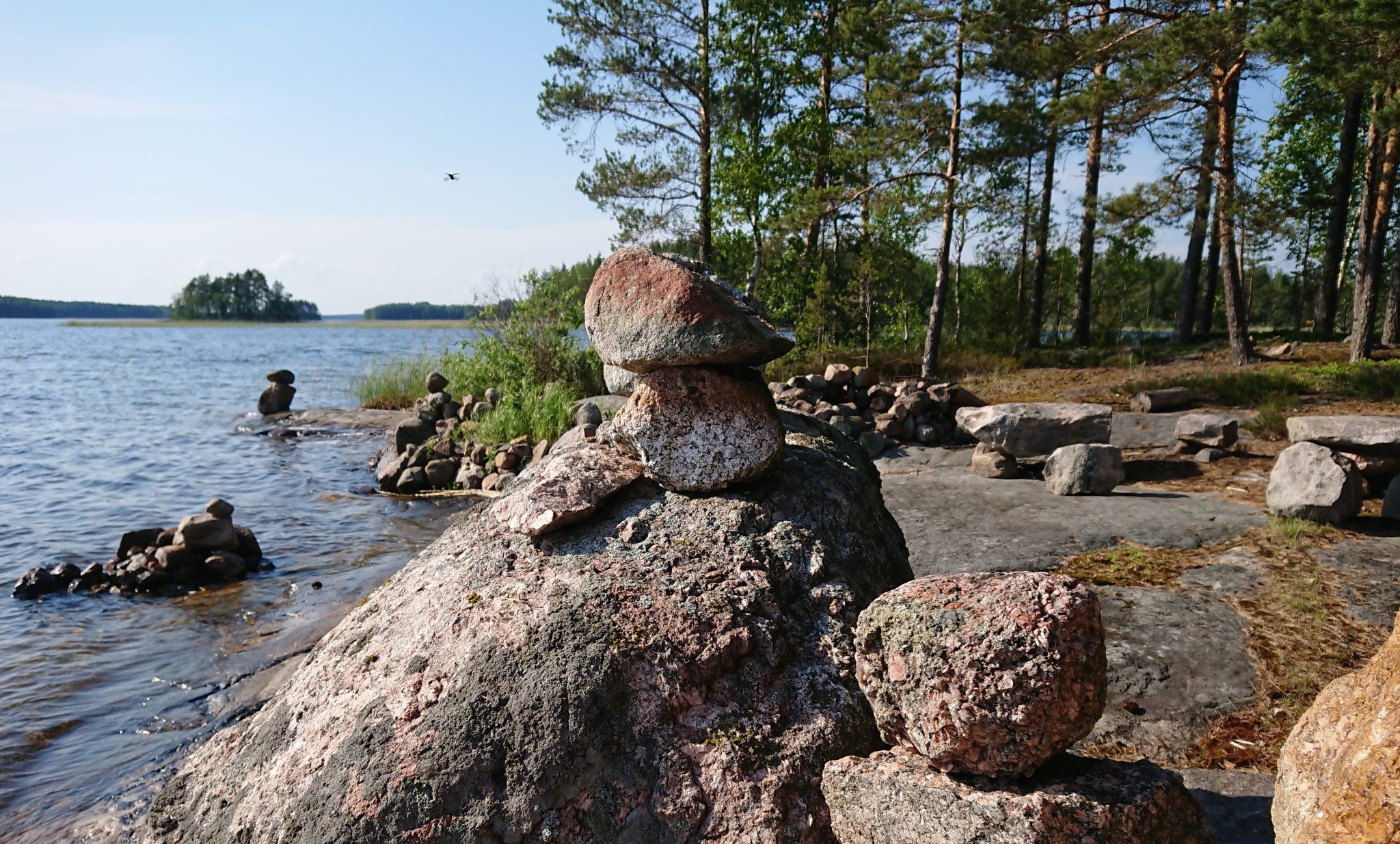The best-known type of rock in Saimaa Geopark is rapakivi granite
Rock samples
Amadeus rock
Amadeus rock or garnet-cordierite-gneiss is a multicoloured, mainly greenish, gneissic rock native to the Sulkava region. Gneisses are metamorphic rocks that have formed when a pre-existing rock has recrystallized under high pressure and temperature. Amadeus has originally been a part of an ancient seabed that ended up in a mountain folding event about 1,900–1,800 million years ago. During the upheaval of Earth’s crust, the rock has partly melted, recrystallized and transformed into banded gneiss. On it, light granitic veins, dark gneissic bands and reddish garnet mineralizations can be seen. Because of its elegant multicoloured texture, Amadeus is used in interior decoration and monuments.
Main minerals: feldspar, quartz, biotite, cordierite, garnet
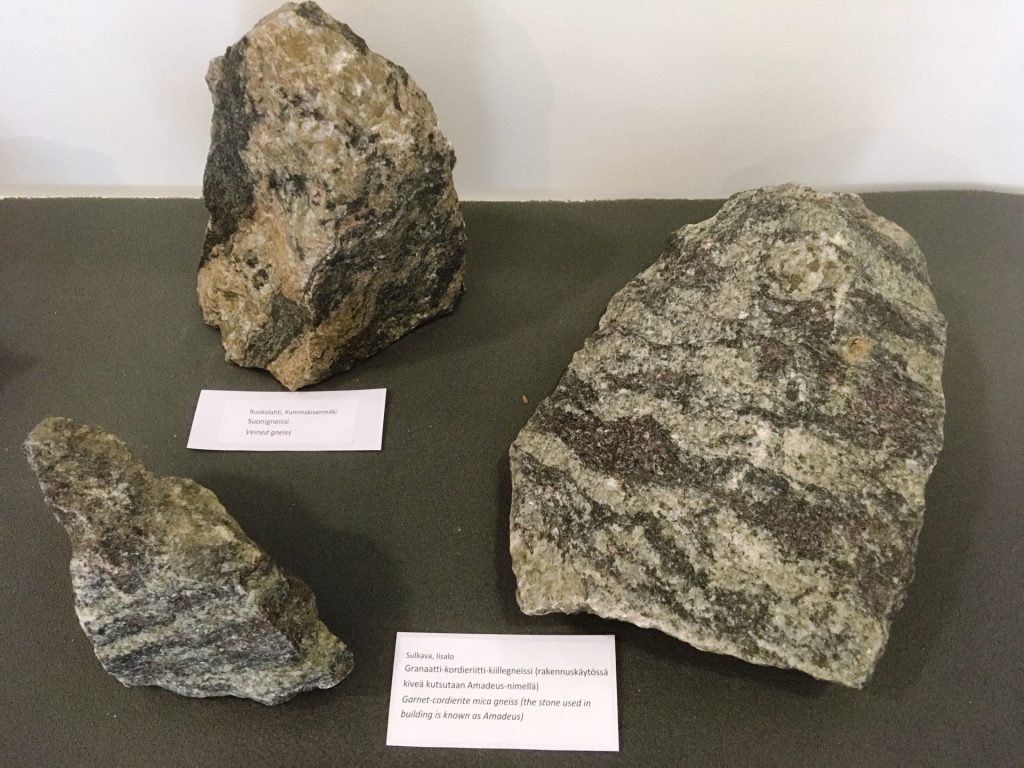
Blue calcite
Calcite or calcium carbonate, found from the Ihalainen excavation, Lappeenranta, is bluish marble. Small-scale limestone deposits are scattered all over Finland. They have formed from chalk rich material, stratified in an ancient shallow, warm sea. Since then, the rocks have gone through several stages of metamorphosis and, in some cases, have hardened to beautiful marbles. Calcitic limestone is used for many purposes, for instance as a resource for burned chalk and cement, and as an industry and soil improvement agent.
Main minerals: calcium carbonate
Carbonate rock
Carbonate rocks are composed mostly of carbonate minerals, usually calcite or dolomite. They are typically formed on the seabed either by precipitation or when the remains of chalk-shelled organisms accumulate. The carbonate rocks in Finnish old bedrock have gone through metamorphosis several times because of rising pressure and temperature.
Main minerals: calcite, (dolomite)
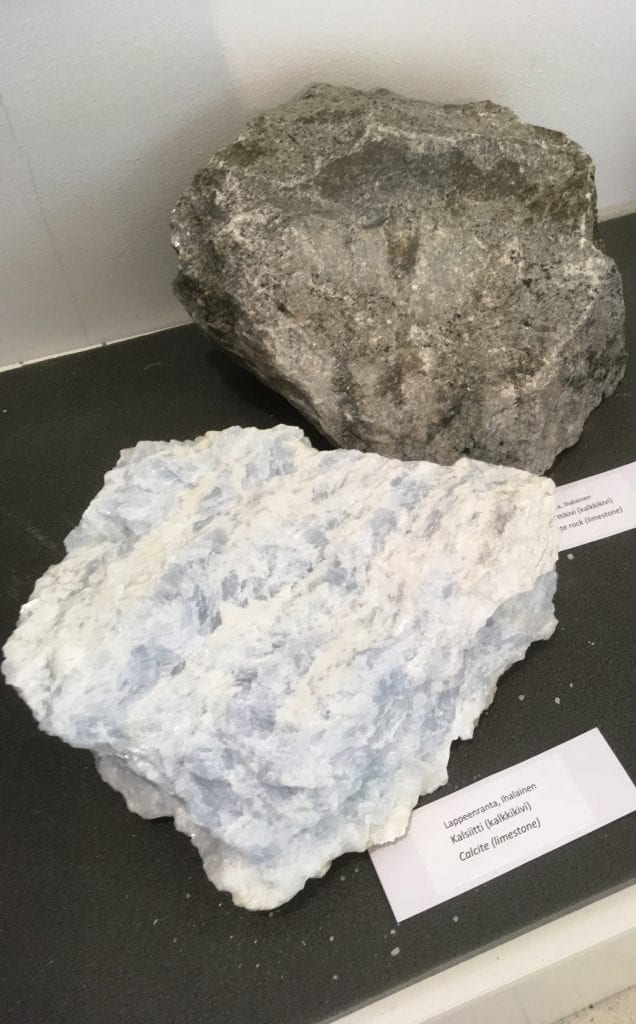
Gabbro
Gabbros are dark plutonic rocks, crystallized from molten magma deep in the Earth’s crust. Their alkaline composition is the same as in basaltic lavas which are dismantled especially at the middle ridges of oceans. Gabbros and other alkaline plutonic rocks are economically valuable because they apply well as a resource for the building industry and they offer significant nickel-chrome and copper deposits. Gabbro is also known as ”black granite” but this term is quite misleading as their chemical and mineralogical composition differs from each other.
Main minerals: pyroxene, plagioclase, hornblende, olivine
Granite
Granite is an igneous rock that slowly crystallized from magma deep in the Earth’s crust. Due to the slow crystallization, the minerals have been able to grow to rather big grains. Granite's name comes from the Latin word granum, meaning grain. Most of our granites have been formed approximately 1900–1800 million years ago. Granite is one of the most common rocks in our bedrock and it has been declared our national rock. Granitic rocks naturally contain small quantities of uranium and thorium which are unstable elements and therefore emit radioactive radiation and produce radioactive gas radon. Granite is hard and tough and is well suited as a construction material.
Main minerals: potassium feldspar, plagioclase, quartz, micas
Granite pegmatite
Very coarse-grained igneous rocks are called pegmatites. Their grain size varies but the coarsest-grained ones can contain crystals of several meters in size. Pegmatites typically occur as veins or lenses and their chemical composition corresponds to their surrounding rocks. Granitic pegmatites are the most common ones. Pegmatites often contain gemstones such as beryl and topaz as well as hi-tech metals, which provides economic interest for their exploitation.
Main minerals: feldspar, quartz, micas
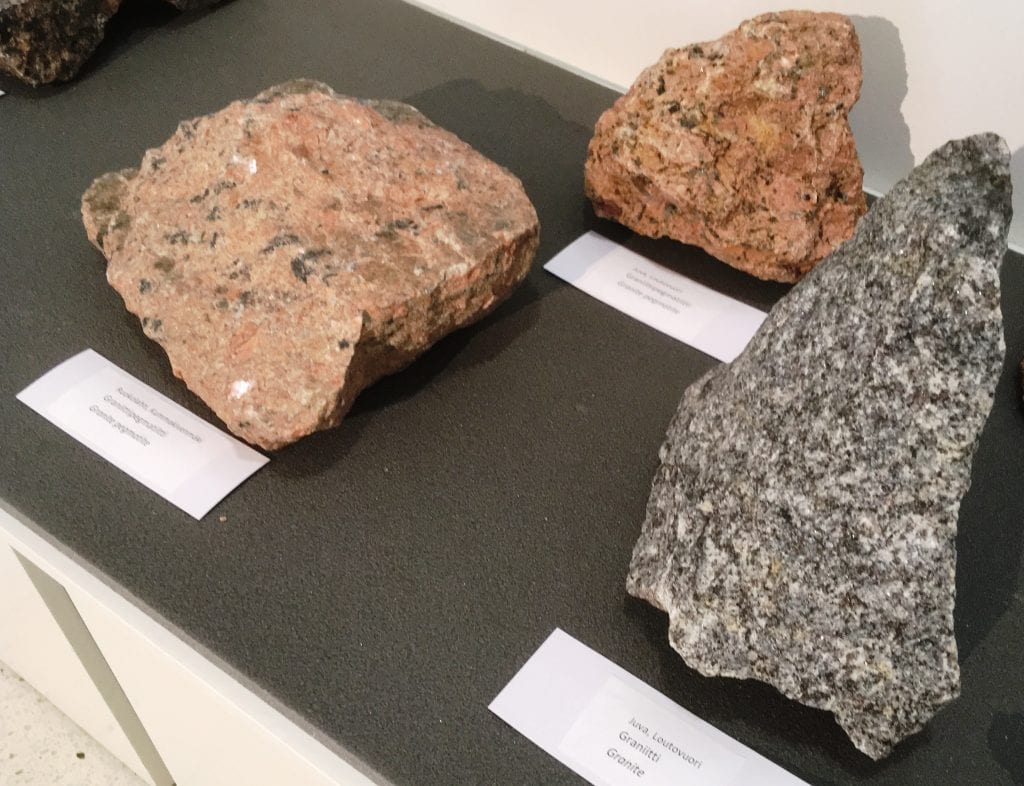
Granodiorite
Granodiorite is a granite-like igneous rock. The main difference between these two is the fact that granodiorite contains more plagioclase than potassium feldspar, unlike granite. Granodiorites also tend to be more dark-coloured compared to granites, which is because of the black mineral hornblende.
Main minerals: plagioclase, potassium feldspar, quartz, micas, (hornblende)
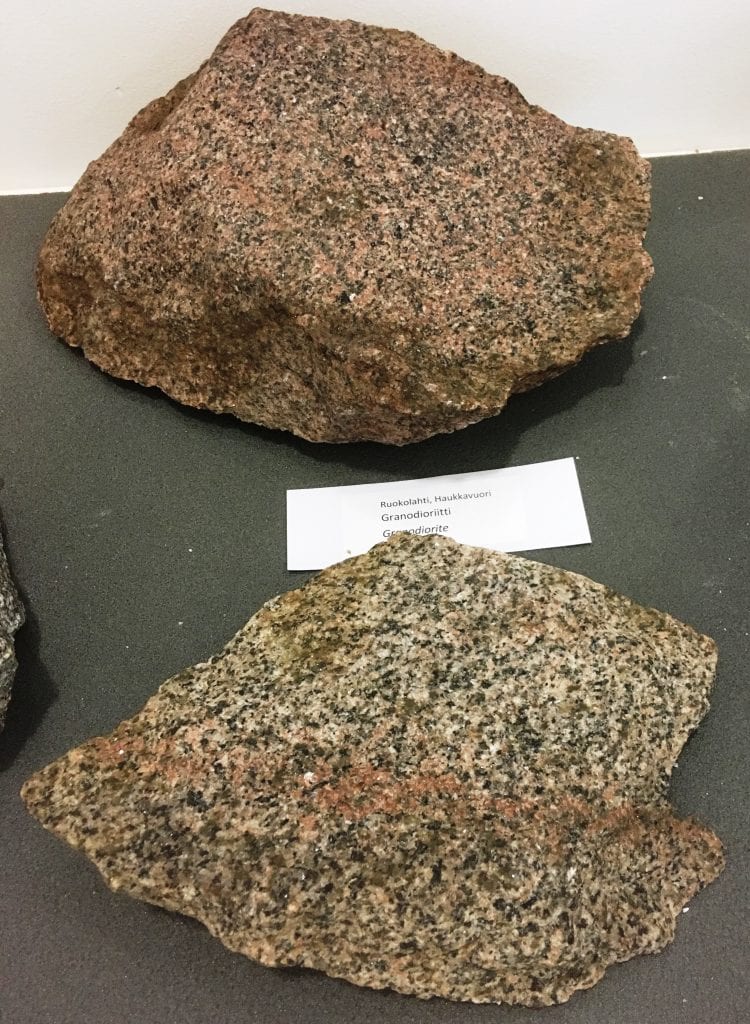
Plagioclase porphyrite
This plagioclase porphyrite is a metamorphic volcanic rock. Volcanites are composed of solidified and crystallized lava, dismantled on the ground surface or near it. From Finland’s ancient bedrock, these kinds of surface rocks have eroded away ages ago, despite some fragments which have got wedged deep in the crust as a result of several plate collision events. These fragments of the old crust have gone through a metamorphosis in high pressure and temperature. The light thin grains scattered in the fine matrix of this rock are plagioclase minerals.

Rapakivi granite
Rapakivi is one of the few Finnish words that have been adopted to other languages as they are. The name is derived from the word ”rapautua” (= weather) due to the rock's tendency to easily erode. Rapakivi granites are native to all continents and most of them have been formed in Middle-Proterozoic, 1,800–1,000 million years ago. In Finland, rapakivi granites occur as wide areas and they are crystallized remnants of the magma chambers of ancient volcanoes. After millions of years of erosion, the rocks have been revealed to the surface. Rapakivi granites (1,650–1,540 million years) are some of the youngest rocks of our ancient bedrock. They are relatively easy to identify from their 1–5 cm wide potassium feldspar ovoids which can have light circles of plagioclase around them. The name for that kind of rapakivi is viborgite.
Main minerals: potassium feldspar, plagioclase, quartz, micas
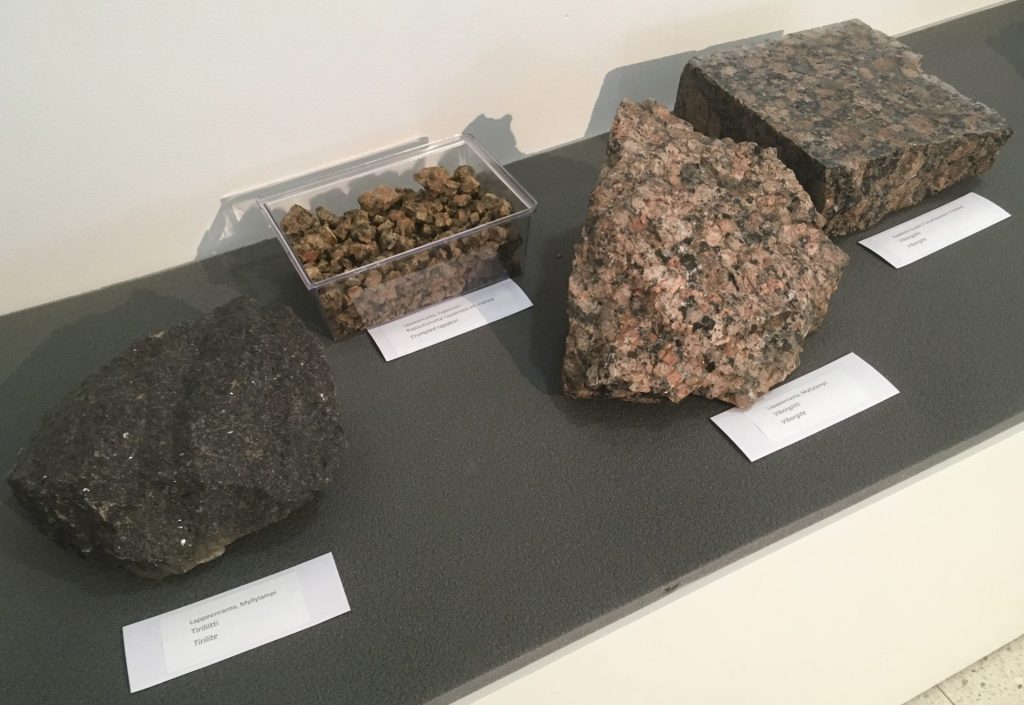
Tirilite
Tirilite is a fayalite bearing, dark-coloured and even-grained variant of rapakivi granite. Its identification at first sight might be challenging due to its unusual dark colour. The name of this rock comes after its finding site, the Tirilä village of Lappeenranta.
Main minerals: potassium feldspar, plagioclase, quartz, olivine (fayalite), hornblende
IDENTIFYING MINERALS
Minerals are crystalline compounds found in nature. Rocks consist of mineral grains and the most common ones are quartz, feldspar and micas. The exact determination can be, however, difficult without laboratory studies. If the mineral grains in the rock are rather large, a preliminary identification can be carried out by studying the physical properties of the minerals. A geohiker who wants to learn mineral identification can use a steel spike or knife, a magnet, non-glassed porcelain and a magnifying glass.
Crystal structure and appearance
Every mineral has its own uniform crystal structure. This structure defines what kind of surface shapes are possible for the grain. The physical conditions during the crystallization define what kind of shapes the mineral can form. Sometimes the physical environment allows the mineral to form perfect crystals, expressing its characteristic crystal structure. However, these kinds of perfect crystals are relatively rare in nature. Still, minerals can be identified by their appearance, for they can often reveal the crystal structure of the mineral. For example, flat or thin grains are usually micas.
Hardness
Hardness is often a good single essence. When identifying minerals by their hardness, we can use the Mohs denary scale for hardness, in which 1 = the softest (chalk) and 10 = the hardest (diamond). A mineral upper in the scale grazes the lower ones and minerals with the same hardness graze each other. When defining the hardness, a steel spike or knife (hardness = 5,5) or an iron nail (~5) can prove useful. The tool cannot graze any material harder than itself. Minerals harder than quartz (>7) are usually gemstones.
Mohs scale
10 diamond
9 corund
8 topaz
7 quartz
6 feldspar
5 apatite
4 fluorite
3 calcite
2 qypsum
1 chalk
Color and scratch
The color of the mineral can be useful in the identification but generally speaking, it is a rather weak sign because the same mineral can occur in several colors. Scratch means the color of mineral powder and it is a significant feature, especially when identifying ore minerals. The scratch can be made by grazing the mineral against non-glassed porcelain like an old fuse. Ore minerals (oxides and sulphides) give a strong-colored darkish scratch and other minerals typically a pale scratch. Thus, silicates give usually a gray or green scratch, whereas the dark ore mineral’s scratch is black, brown or red.
Magnetism
When considering the most common minerals, only magnetite shows strong magnetism. Magnetism is an important sign when distinguishing magnetite from other ore minerals. Pyrrhotite shows magnetism occasionally. The iron meteorites are often magnetic. Whether the mineral is magnetic or not can be noticed with a magnet.
